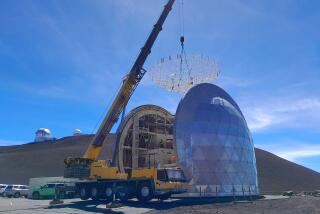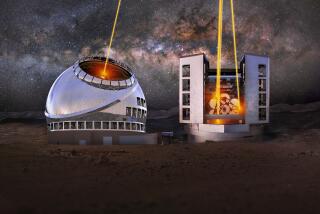Caltech Gets Grant to Build World’ Largest Telescope : $70 Million for Project on Volcano
Plans to build a telescope so powerful it could detect a candle on the surface of the moon were announced today at California Institute of Technology.
The 400-inch instrument, to be built atop Mauna Kea on the island of Hawaii, will be the largest optical telescope in the world, twice the size and four times as powerful as the Hale Telescope on Palomar Mountain, currently the largest such instrument in the United States.
A $70-million grant from the W. M. Keck Foundation of Los Angeles will make the project possible. The grant was described as the largest private grant in history for a scientific project.
The instrument will be named the Keck Telescope after William M. Keck, founder of Superior Oil Co. who established the foundation that bears his name in 1954, 10 years before his death. It will be operated under a joint agreement involving the foundation, Caltech and the University of California.
Earlier Grant to UC
The telescope is a carbon copy of one that was to have been built by the University of California with a $36-million grant from the Marion O. Hoffman Trust. That grant was announced by Marion Hoffman, widow of foreign car importer Maximilian E. Hoffman, the day before her death in December, 1983. Had those plans been carried out, the instrument would have been named the Hoffman Observatory, but UC President David P. Gardner said the grant turned out to be only about half of the expected cost, so the Hoffman Observatory will be scrapped in favor of the Keck Telescope.
Caltech President Marvin L. Goldberger, who announced the plans with Gardner and two representatives of the Keck Foundation, described the announcement as “a historic occasion” and read congratulatory telegrams from President Reagan and Gov. George Deukmejian.
Howard B. Keck and Julian O. von Kalinowski, chairman and director of the Keck Foundation, said the grant will be awarded as soon as contractual agreements are reached. Both said the agreements are legal matters and should not delay the project.
It will take more than six years to build the observatory, which will be constructed on land owned by the University of Hawaii, which also will have access to the instrument. Construction is scheduled to begin next year on a 13,600-foot ridge on Mauna Kea, described by Goldberger as “the world’s greatest astronomical site.”
Link With Space Telescope
The telescope will be nearly twice the size of the largest optical telescope in the world, a 236-inch instrument in the Caucasus Mountains in the Soviet Union. It will work in concert with the Space Telescope, scheduled to be launched into orbit from the space shuttle in 1986.
The Space Telescope, which will operate above Earth’s atmosphere, far from the detrimental effect of air pollution and background lighting, will be able to pick out celestial objects too faint to have been detected by earthbound telescopes.
However, the huge mirrors of the Keck Telescope will have far greater light-gathering capabilities than the smaller Space Telescope, and scientists who attended today’s press conference said it will permit detailed research of faint targets found by the orbiting system.
Goldberger said the telescope should permit scientists to study objects that are 12 billion light-years away from Earth, thus possibly yielding clues to the origin of the universe, which is generally believed to be about 15 billion years old. In contrast, the Hale Telescope extends about 8 billion light-years, Goldberger said.






